Towards More Reliable Measures for “Perceived Urban Diversity” Using Point of Interest (POI) and Geo-Tagged Photos
Abstract
:1. Introduction
2. Literature Review
2.1. Urban Vitality and Its Quantification
2.2. Measuring Urban Diversity
3. Data and Methodology
3.1. Study Area and Data Used
- Baidu heatmap: Baidu heatmap describes the total number of times visit locations are visited by people at any time of the day [54]. Therefore, the 24 h Baidu heatmap is used here as a surrogate for urban vitality. To understand the interplay between the proposed diversity indicator and vitality and its variations, Baidu heatmaps for two weekdays and two weekends (spanning 7–10 January 2023) were chosen as the vitality proxies for this study.
- Gaode POI: The POI dataset is sourced from Gaode Maps, a major platform that offers map services in China. As of June 2022, this dataset comprises over 600,000 POIs under 23 major categories specific to Shenzhen. The functional attributes of POIs and their spatial distribution are shown in Figure 3.
- Geo-tagged images: Geo-tagged data derived from the Weibo, a famous social media in China. Weibo-geo-tagged image dataset comprises images shared by users on the Weibo platform. We extracted 75,663 images from Weibo check-in data from December 2022 to March 2023. After the data cleaning and screening, 41,055 valid images were obtained. The spatial distribution of the images and scene categories are shown in Figure 3.
- Shenzhen planning map: Shenzhen planning map is obtained from Shenzhen municipal government, which mainly includes 11 types of land use.
3.2. Overall Framework
3.3. Extraction of Urban Semantics
3.4. Perceived Diversity Indicators
3.4.1. Shannon’s Diversity Indicator (SHDI)
3.4.2. Area-Based SHDI
3.4.3. Accessibility-Based SHDI
3.5. Vitality Proxy
3.6. Correlation Analysis
4. Results and Analysis
4.1. Explorative Analysis
4.1.1. Spatial Distribution of Vitality Proxy
4.1.2. Spatial Distribution of Traditional Diversity Indicators
4.1.3. Spatial Distribution of Area-Based SHDI
4.1.4. Spatial Distribution of Accessibility-Based SHDI
4.2. Interaction Between “Perceived Diversity” and Vitality
4.2.1. The Impact of Diversity Measures and Other Factors on Urban Vitality
4.2.2. Diversity Measured from Multiple Data Sources Is More Representative
4.2.3. “Perceived Diversity” Better Corresponds to Urban Vitality
- Both functional semantics from POIs and visual semantics from geo-tagged photos are equally important in understanding and characterizing urban diversity.
- Diversity indicators derived from the combination of POIs and geo-tagged photos better depict the diversity of Shenzhen neighborhoods.
- The proposed “perceived diversity” indicators, specifically area- and accessibility-based SHDI, significantly strengthen the correlation between urban vitality and diversity, among which the accessibility-based diversity indicator performed the best.
4.2.4. How Diversity Contributes to Vitality Under Different Land-Use Type?
5. Discussion
5.1. Implications of “Perceived Diversity”
5.2. Daytime and Nighttime Variations
5.3. Limitations and Challenges
5.4. Recommendations to Urban Planning
6. Conclusions
Supplementary Materials
Author Contributions
Funding
Data Availability Statement
Acknowledgments
Conflicts of Interest
References
- Huang, B.; Zhou, Y.; Li, Z.; Song, Y.; Cai, J.; Tu, W. Evaluating and characterizing urban vibrancy using spatial big data: Shanghai as a case study. Environ. Plan. B Urban Anal. City Sci. 2020, 47, 1543–1559. [Google Scholar] [CrossRef]
- Xia, C.; Yeh, A.G.-O.; Zhang, A. Analyzing spatial relationships between urban land use intensity and urban vitality at street block level: A case study of five Chinese megacities. Landsc. Urban Plan. 2020, 193, 103669. [Google Scholar] [CrossRef]
- Li, M.; Liu, J.; Lin, Y.; Xiao, L.; Zhou, J. Revitalizing historic districts: Identifying built environment predictors for street vibrancy based on urban sensor data. Cities 2021, 117, 103305. [Google Scholar] [CrossRef]
- Li, Y.; Yabuki, N.; Fukuda, T. Exploring the association between street built environment and street vitality using deep learning methods. Sustain. Cities Soc. 2022, 79, 103656. [Google Scholar] [CrossRef]
- Wang, X.; Zhang, Y.; Yu, D.; Qi, J.; Li, S. Investigating the spatiotemporal pattern of urban vibrancy and its determinants: Spatial big data analyses in Beijing, China. Land Use Policy 2022, 119, 106162. [Google Scholar] [CrossRef]
- Wu, C.; Ye, Y.; Gao, F.; Ye, X. Using street view images to examine the association between human perceptions of locale and urban vitality in Shenzhen, China. Sustain. Cities Soc. 2023, 88, 104291. [Google Scholar] [CrossRef]
- Jacobs, J. The Death and Life of Great American Cities; Random House, Inc.: New York, NY, USA, 1961. [Google Scholar]
- Marquet, O.; Viiralles-Guasch, C. Neighbourhood vitality and physical activity among the elderly: The role of walkable environments on active ageing in Barcelona, Spain. Soc. Sci. Med. 2015, 135, 24–30. [Google Scholar] [CrossRef] [PubMed]
- Ye, Y.; Li, D.; Liu, X. How block density and typology affect urban vitality: An exploratory analysis in Shenzhen, China. Urban Geogr. 2018, 39, 631–652. [Google Scholar] [CrossRef]
- Chen, Z.; Dong, B.; Pei, Q.; Zhang, Z. The impacts of urban vitality and urban density on innovation: Evidence from China’s Greater Bay Area. Habitat Int. 2022, 119, 102490. [Google Scholar] [CrossRef]
- Lao, X.; Gu, H.; Yu, H.; Xiao, F. Exploring the Spatially-Varying Effects of Human Capital on Urban Innovation in China. Appl. Spat. Anal. Policy 2021, 14, 827–848. [Google Scholar] [CrossRef]
- Tang, L.; Lin, Y.; Li, S.; Li, S.; Li, J.; Ren, F.; Wu, C. Exploring the Influence of Urban Form on Urban Vibrancy in Shenzhen Based on Mobile Phone Data. Sustainability 2018, 10, 4565. [Google Scholar] [CrossRef]
- Yue, W.; Chen, Y.; Zhang, Q.; Liu, Y. Spatial Explicit Assessment of Urban Vitality Using Multi-Source Data: A Case of Shanghai, China. Sustainability 2019, 11, 638. [Google Scholar] [CrossRef]
- Kang, C.; Fan, D.; Jiao, H. Validating activity, time, and space diversity as essential components of urban vitality. Environ. Plan. B-Urban Anal. City Sci. 2021, 48, 1180–1197. [Google Scholar] [CrossRef]
- Jiang, B.; Huang, J.-T. A new approach to detecting and designing living structure of urban environments. Comput. Environ. Urban Syst. 2021, 88, 101646. [Google Scholar] [CrossRef]
- Wang, L.; Han, X.; He, J.; Jung, T. Measuring residents’ perceptions of city streets to inform better street planning through deep learning and space syntax. Isprs J. Photogramm. Remote Sens. 2022, 190, 215–230. [Google Scholar] [CrossRef]
- Tu, W.; Zhu, T.; Xia, J.; Zhou, Y.; Lai, Y.; Jiang, J.; Li, Q. Portraying the spatial dynamics of urban vibrancy using multisource urban big data. Comput. Environ. Urban Syst. 2020, 80, 101428. [Google Scholar] [CrossRef]
- Yue, Y.; Zhuang, Y.; Yeh, A.G.-O.; Xie, J.-Y.; Ma, C.-L.; Li, Q.-Q. Measurements of POI-based mixed use and their relationships with neighbourhood vibrancy. Int. J. Geogr. Inf. Sci. 2017, 31, 658–675. [Google Scholar] [CrossRef]
- Zhang, J.; Liu, X.; Tan, X.; Jia, T.; Senousi, A.M.; Huang, J.; Yin, L.; Zhang, F. Nighttime Vitality and Its Relationship to Urban Diversity: An Exploratory Analysis in Shenzhen, China. IEEE J. Sel. Top. Appl. Earth Obs. Remote Sens. 2022, 15, 309–322. [Google Scholar] [CrossRef]
- Long, Y.; Huang, C.C. Does block size matter? The impact of urban design on economic vitality for Chinese cities. Environ. Plan. B Urban Anal. City Sci. 2019, 46, 406–422. [Google Scholar] [CrossRef]
- Niu, N.; Li, L.; Li, X.; He, J. The structural dimensions and community vibrancy: An exploratory analysis in Guangzhou, China. Cities 2022, 127, 103771. [Google Scholar] [CrossRef]
- Zhuo, Y.; Zheng, H.; Wu, C.; Xu, Z.; Li, G.; Yu, Z. Compatibility mix degree index: A novel measure to characterize urban land use mix pattern. Comput. Environ. Urban Syst. 2019, 75, 49–60. [Google Scholar] [CrossRef]
- Arietta, S.M.; Efros, A.A.; Ramamoorthi, R.; Agrawala, M. City Forensics: Using Visual Elements to Predict Non-Visual City Attributes. IEEE Trans. Vis. Comput. Graph. 2014, 20, 2624–2633. [Google Scholar] [CrossRef]
- Han, S.; Ren, F.; Du, Q.; Gui, D. Extracting Representative Images of Tourist Attractions from Flickr by Combining an Improved Cluster Method and Multiple Deep Learning Models. ISPRS Int. J. Geo Inf. 2020, 9, 81. [Google Scholar] [CrossRef]
- Zhou, B.; Liu, L.; Oliva, A.; Torralba, A. Recognizing City Identity via Attribute Analysis of Geo-tagged Images. In Proceedings of the Computer Vision—ECCV 2014, Zurich, Switzerland, 6–12 September 2014; Springer International Publishing: Cham, Switzerland, 2014. [Google Scholar]
- Zhao, G.; Song, J.; Liu, S. A Comparative Study on the Measurement Methods of Urban Mixed Land Use. China City Plan. Rev. 2022, 31, 58–71. [Google Scholar]
- Ziakopoulos, A.; Yannis, G. A review of spatial approaches in road safety. Accid. Anal. Prev. 2020, 135, 105323. [Google Scholar] [CrossRef] [PubMed]
- Gifford, R.; Nilsson, A. Personal and social factors that influence pro-environmental concern and behaviour: A review. Int. J. Psychol. J. Int. Psychol. 2014, 49, 141–157. [Google Scholar] [CrossRef] [PubMed]
- Ashihara, Y. The Aesthetic Townscape; The MIT Press: Cambridge, MA, USA, 1983. [Google Scholar]
- Lynch, K. The Image of the City; MIT Press: Cambridge, MA, USA, 1960; pp. 46–68. [Google Scholar]
- Maas, P.R. Towards a Theory of Urban Vitality; University of British Columbia: Vancouver, BC, Canada, 1984. [Google Scholar]
- Montgomery, J. Making a city: Urbanity, vitality and urban design. J. Urban Des. 1998, 3, 93–116. [Google Scholar] [CrossRef]
- Harvey, L. Defining and Measuring Employability. Qual. High. Educ. 2001, 7, 97–109. [Google Scholar] [CrossRef]
- Azmi, D.I.; Karim, H.A. Implications of Walkability towards Promoting Sustainable Urban Neighbourhood. In Proceedings of the ASEAN Conference on Environment-Behaviour Studies (AcE-Bs) on Way of Life—Socio-Economic and Cultural Context, Bangkok, Thailand, 16–18 July 2012. [Google Scholar]
- Sung, H.; Lee, S. Residential built environment and walking activity: Empirical evidence of Jane Jacobs’ urban vitality. Transp. Res. Part D Transp. Environ. 2015, 41, 318–329. [Google Scholar] [CrossRef]
- Heipke, C. Crowdsourcing geospatial data. Isprs J. Photogramm. Remote Sens. 2010, 65, 550–557. [Google Scholar] [CrossRef]
- Wu, L.; Zhi, Y.; Sui, Z.; Liu, Y. Intra-Urban Human Mobility and Activity Transition: Evidence from Social Media Check-In Data. PLoS ONE 2014, 9, e97010. [Google Scholar] [CrossRef] [PubMed]
- Wang, B.; Lei, Y.Q.; Wang, C.G.; Wang, L. The Spatio-temporal Impacts of the Built Environment on Urban Vitality: A Study Based on Big Data. Sci. Geogr. Sin. 2022, 42, 274–283. [Google Scholar]
- Jia, C.; Du, Y.; Wang, S.; Bai, T.; Fei, T. Measuring the vibrancy of urban neighborhoods using mobile phone data with an improved PageRank algorithm. Trans. Gis 2019, 23, 241–258. [Google Scholar] [CrossRef]
- Li, Q.; Cui, C.; Liu, F.; Wu, Q.; Run, Y.; Han, Z. Multidimensional Urban Vitality on Streets: Spatial Patterns and Influence Factor Identification Using Multisource Urban Data. Isprs Int. J. Geo-Inf. 2022, 11, 2. [Google Scholar] [CrossRef]
- Zeng, C.; Song, Y.; He, Q.; Shen, F. Spatially explicit assessment on urban vitality: Case studies in Chicago and Wuhan. Sustain. Cities Soc. 2018, 40, 296–306. [Google Scholar] [CrossRef]
- Brown, B.B.; Yamada, I.; Smith, K.R.; Zick, C.D.; Kowaleski-Jones, L.; Fan, J.X. Mixed land use and walkability: Variations in land use measures and relationships with BMI, overweight, and obesity. Health Place 2009, 15, 1130–1141. [Google Scholar] [CrossRef] [PubMed]
- Song, Y.; Merlin, L.; Rodriguez, D. Comparing measures of urban land use mix. Comput. Environ. Urban Syst. 2013, 42, 1–13. [Google Scholar] [CrossRef]
- Shi, B.; Yang, J. Scale, distribution, and pattern of mixed land use in central districts: A case study of Nanjing, China. Habitat Int. 2015, 46, 166–177. [Google Scholar] [CrossRef]
- Im, H.N.; Choi, C.G. The hidden side of the entropy-based land-use mix index: Clarifying the relationship between pedestrian volume and land-use mix. Urban Stud. 2018, 56, 1865–1881. [Google Scholar] [CrossRef]
- Sakoda, J.M. A Generalized Index of Dissimilarity. Demography 1981, 18, 245–250. [Google Scholar] [CrossRef] [PubMed]
- Hunter, P.R.; Gaston, M.A. Numerical index of the discriminatory ability of typing systems: An application of Simpson’s index of diversity. J. Clin. Microbiol. 1988, 26, 2465–2466. [Google Scholar] [CrossRef] [PubMed]
- Handy, S. Methodologies for exploring the link between urban form and travel behavior. Transp. Res. Part D Transp. Environ. 1996, 1, 151–165. [Google Scholar] [CrossRef]
- Zhou, B.; Lapedriza, A.; Khosla, A.; Oliva, A.; Torralba, A. Places: A 10 Million Image Database for Scene Recognition. IEEE Trans. Pattern Anal. Mach. Intell. 2018, 40, 1452–1464. [Google Scholar] [CrossRef]
- Zhang, F.; Zhang, D.; Liu, Y.; Lin, H. Representing place locales using scene elements. Comput. Environ. Urban Syst. 2018, 71, 153–164. [Google Scholar] [CrossRef]
- Zhou, B.; Lapedriza, A.; Xiao, J.; Torralba, A.; Oliva, A. Learning Deep Features for Scene Recognition using Places Database. In Proceedings of the Neural Information Processing Systems, Montreal, QC, USA, 8–13 December 2014. [Google Scholar]
- Guerrero, P.; Møller, M.S.; Olafsson, A.S.; Snizek, B. Revealing Cultural Ecosystem Services through Instagram Images: The Potential of Social Media Volunteered Geographic Information for Urban Green Infrastructure Planning and Governance. Urban Plan. 2016, 1, 1–17. [Google Scholar] [CrossRef]
- Lu, H.-Y.; Lou, Y.-T.; Jin, B.; Xu, M. What is Discussed about COVID-19: A Multi-modal Framework for Analyzing Microblogs from Sina Weibo without Human Labeling. Comput. Mater. Contin. 2020, 64, 1453–1471. [Google Scholar] [CrossRef]
- Li, X.; Qian, Y.; Zeng, J.; Wei, X.; Guang, X. The Influence of Strip-City Street Network Structure on Spatial Vitality: Case Studies in Lanzhou, China. Land 2021, 10, 1107. [Google Scholar] [CrossRef]
- Luo, W.; Wang, F.H. Measures of spatial accessibility to health care in a GIS environment: Synthesis and a case study in the Chicago region. Environ. Plan. B-Plan. Des. 2003, 30, 865–884. [Google Scholar] [CrossRef]
- Dai, D. Racial/ethnic and socioeconomic disparities in urban green space accessibility: Where to intervene? Landsc. Urban Plan. 2011, 102, 234–244. [Google Scholar] [CrossRef]
- Wang, J.; Kwan, M.P.; Chai, Y.W. An Innovative Context-Based Crystal-Growth Activity Space Method for Environmental Exposure Assessment: A Study Using GIS and GPS Trajectory Data Collected in Chicago. Int. J. Environ. Res. Public Health 2018, 15, 703. [Google Scholar] [CrossRef] [PubMed]
- Ulloa-Leon, F.; Correa-Parra, J.; Vergara-Perucich, F.; Cancino-Contreras, F.; Aguirre-Nuñez, C. “15-Minute City” and Elderly People: Thinking about Healthy Cities. Smart Cities 2023, 6, 1043–1058. [Google Scholar] [CrossRef]
- Shahri, M.; Shahri, M.; Mirzaie, M. Bivariate Moran’s I and Lisa to explore the crash risky locations in urban areas. N-Aerus 2013, 14, 1–12. [Google Scholar]
- Meng, Y.; Xing, H. Exploring the relationship between landscape characteristics and urban vibrancy: A case study using morphology and review data. Cities 2019, 95, 102389. [Google Scholar] [CrossRef]
- Macarthur, R.H. Patterns of Species Diversity. Biol. Rev. 1965, 40, 510–533. [Google Scholar] [CrossRef]
- Fan, Z.; Zhang, F.; Loo, B.P.Y.; Ratti, C. Urban visual intelligence: Uncovering hidden city profiles with street view images. Proc. Natl. Acad. Sci. USA 2023, 120, e2220417120. [Google Scholar] [CrossRef] [PubMed]
- Ito, K.; Kang, Y.; Zhang, Y.; Zhang, F.; Biljecki, F. Understanding urban perception with visual data: A systematic review. Cities 2024, 152, 105169. [Google Scholar] [CrossRef]
- Vecchi, R.; Marcazzan, G.; Valli, G. A study on nighttime–daytime PM10 concentration and elemental composition in relation to atmospheric dispersion in the urban area of Milan (Italy). Atmos. Environ. 2007, 41, 2136–2144. [Google Scholar] [CrossRef]
- Khamis, K.; Ouellet, V.; Croghan, D.; Gonzalez, L.M.H.; Packman, A.I.; Hannah, D.M.; Krause, S. The Autobot-WQ: A portable, low-cost autosampler to provide new insight into urban spatio-temporal water quality dynamics. Front. Built Environ. 2023, 9, 1072757. [Google Scholar] [CrossRef]
- Duarte, F.; Ratti, C. What Urban Cameras Reveal About the City: The Work of the Senseable City Lab. In Urban Informormatics; Springer: Berlin/Heidelberg, Germany, 2021; pp. 491–502. [Google Scholar]
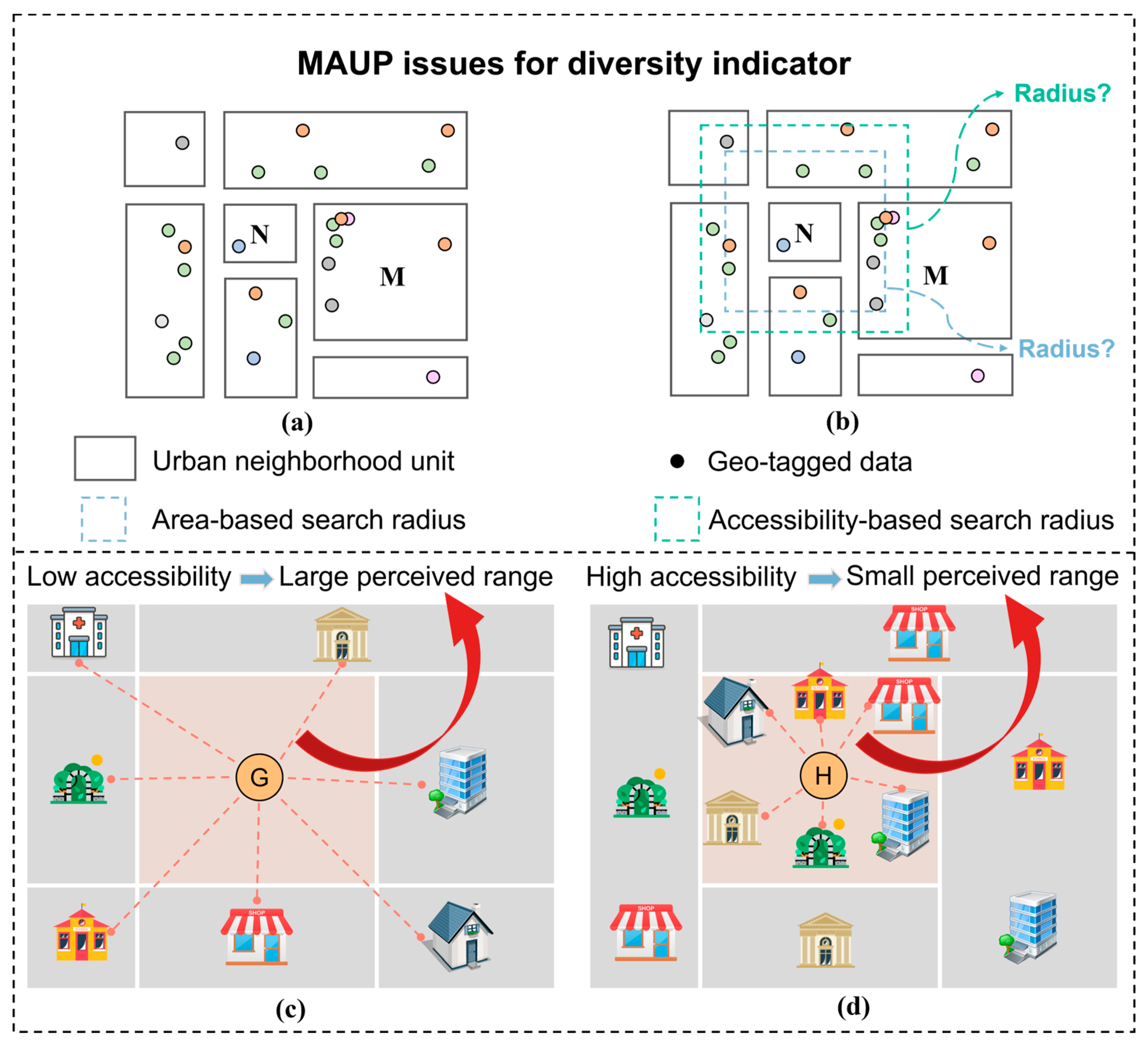
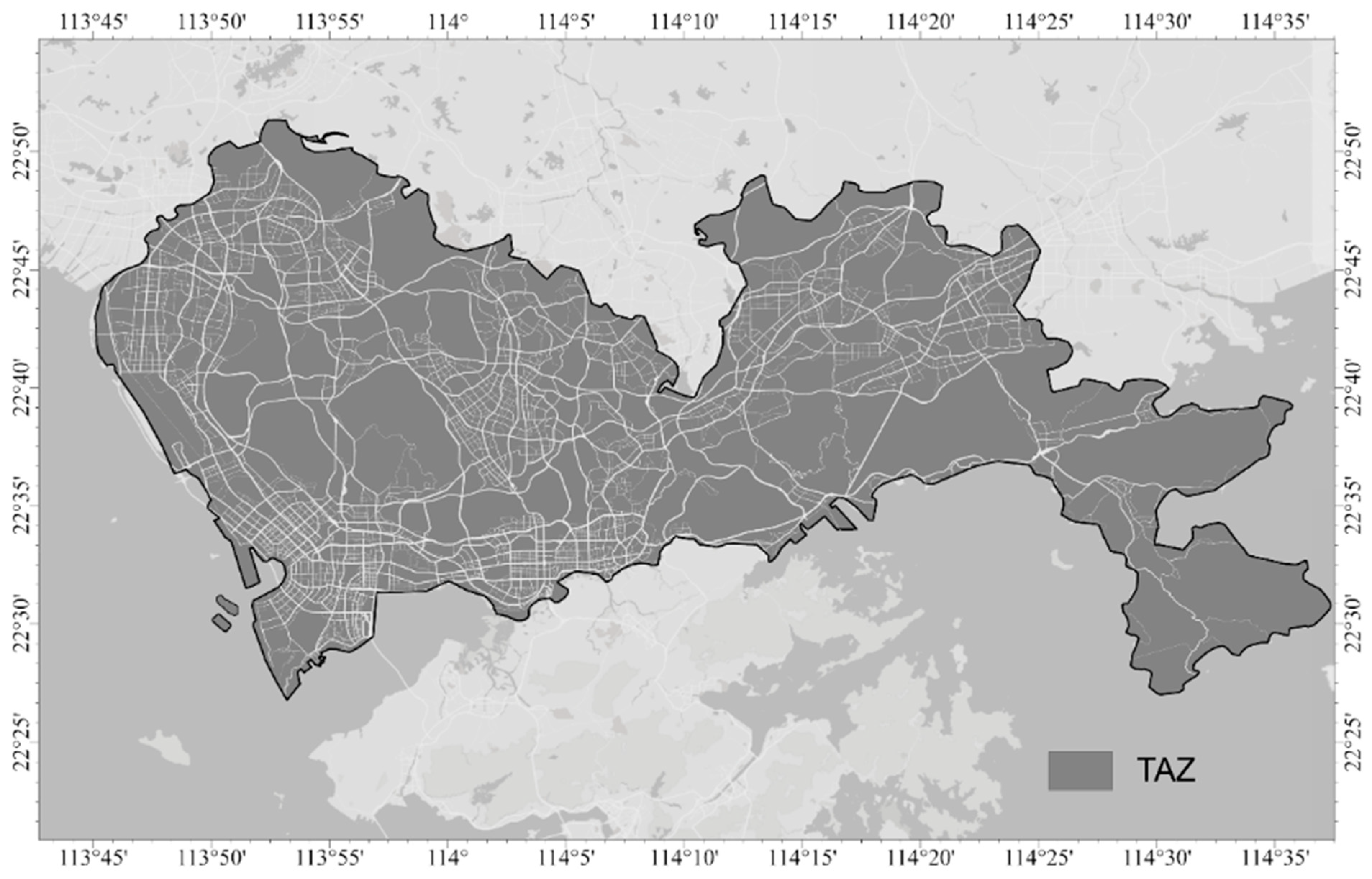
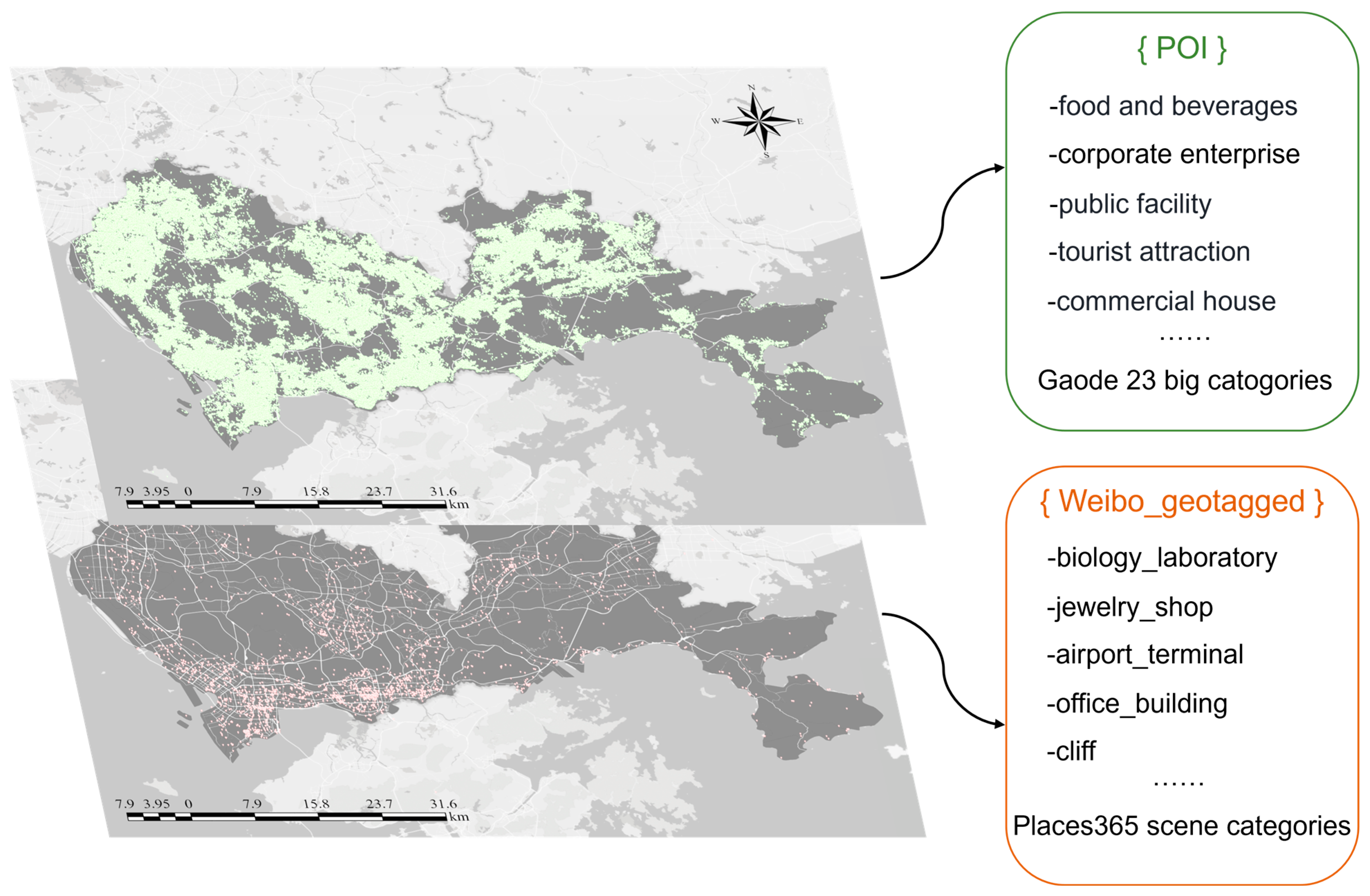

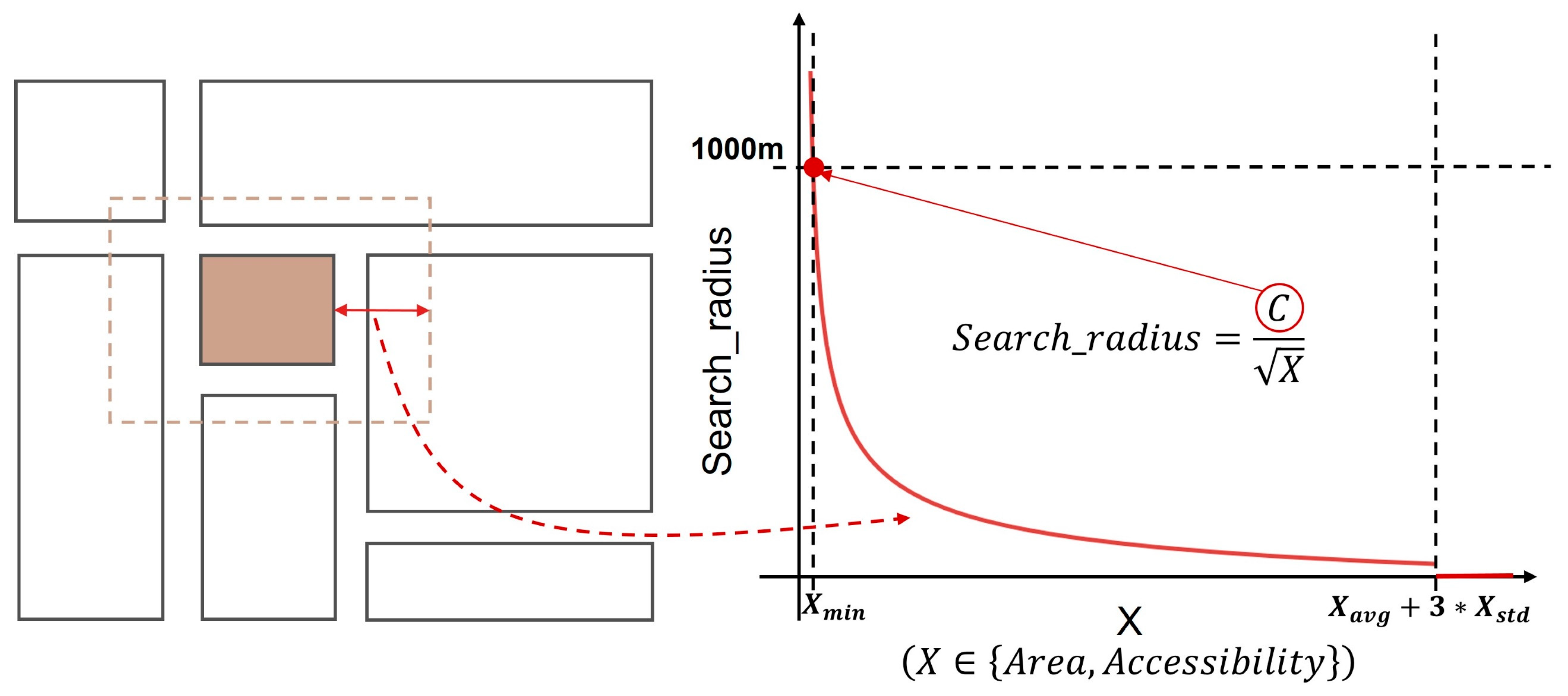

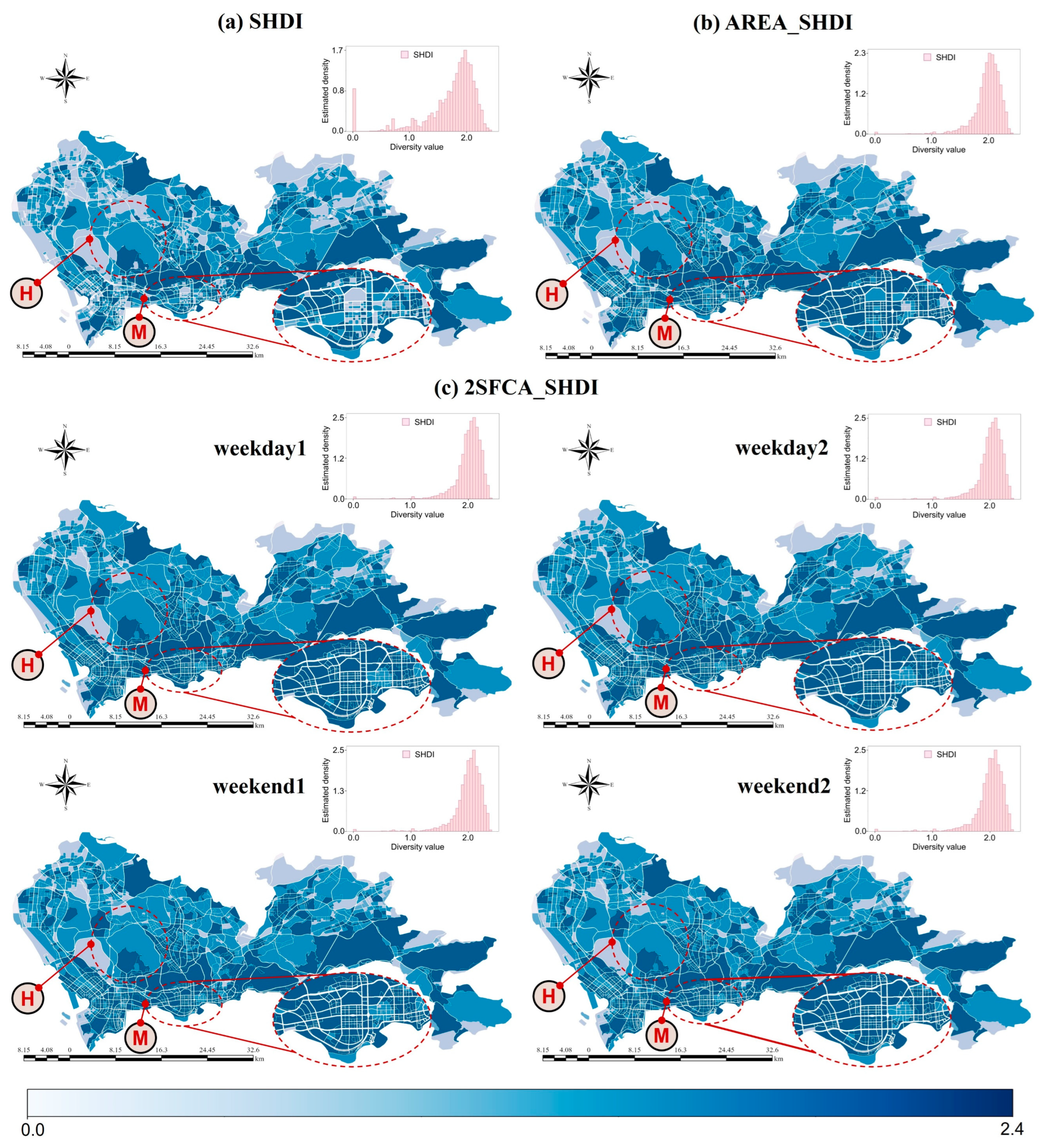
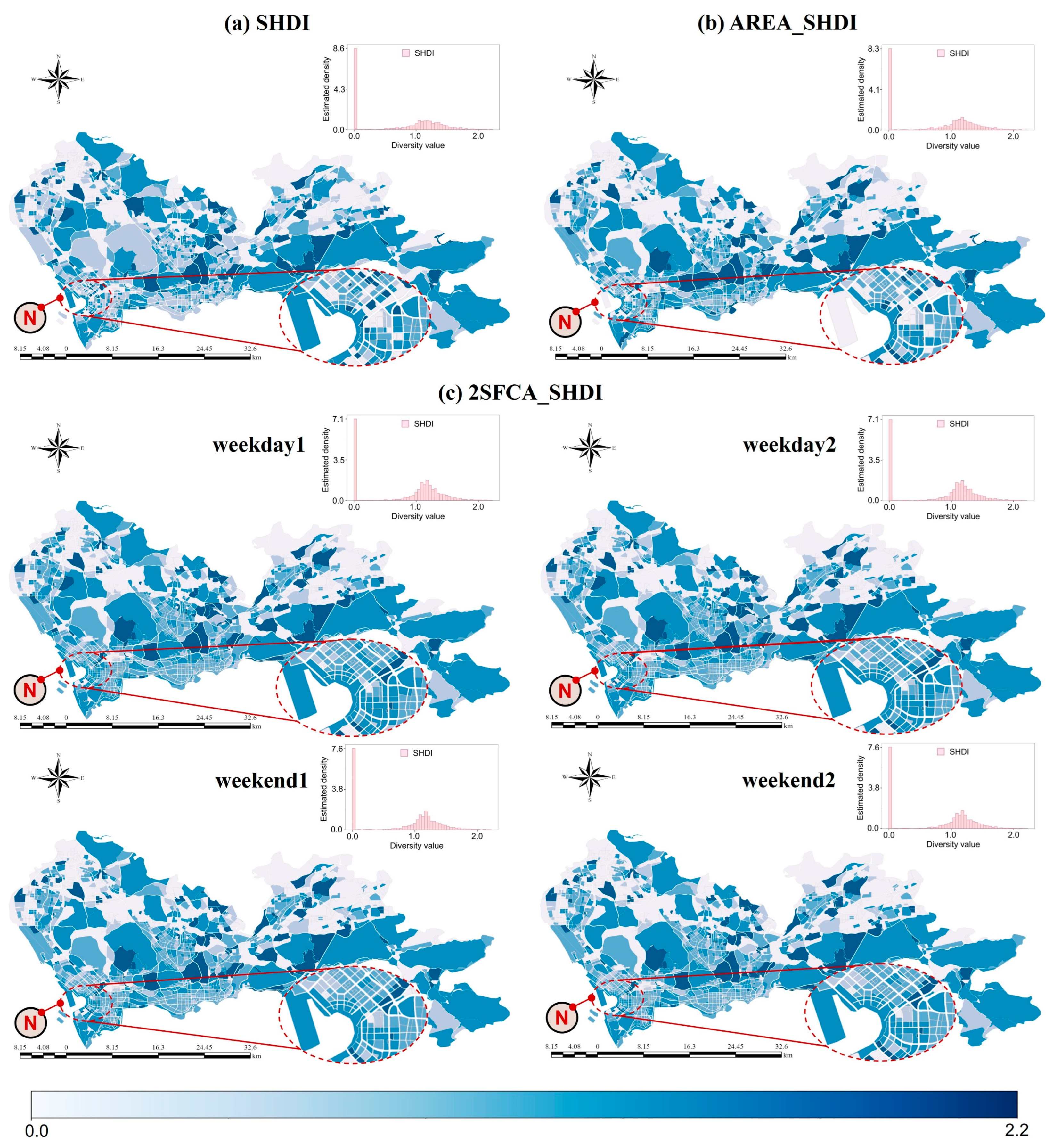
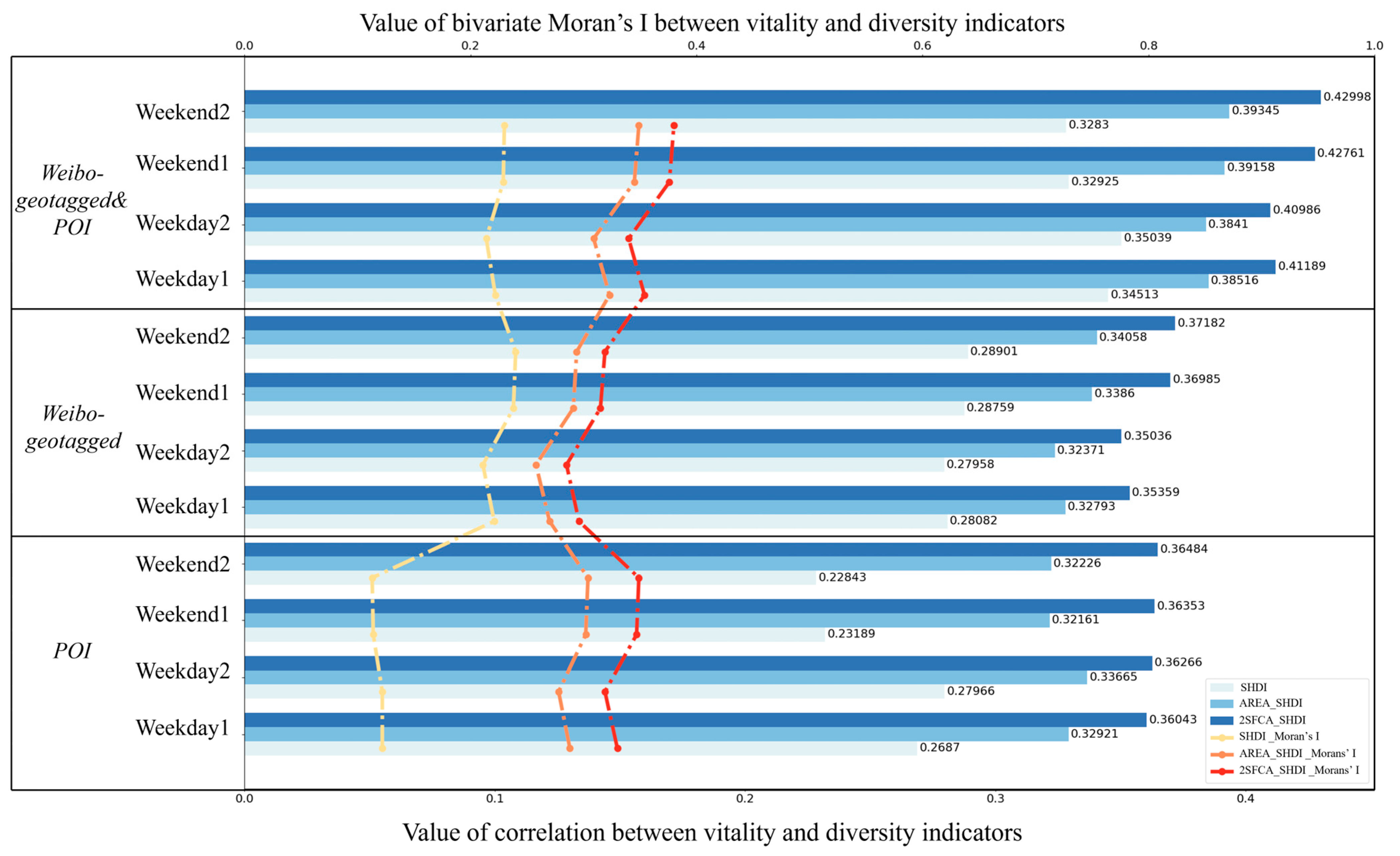
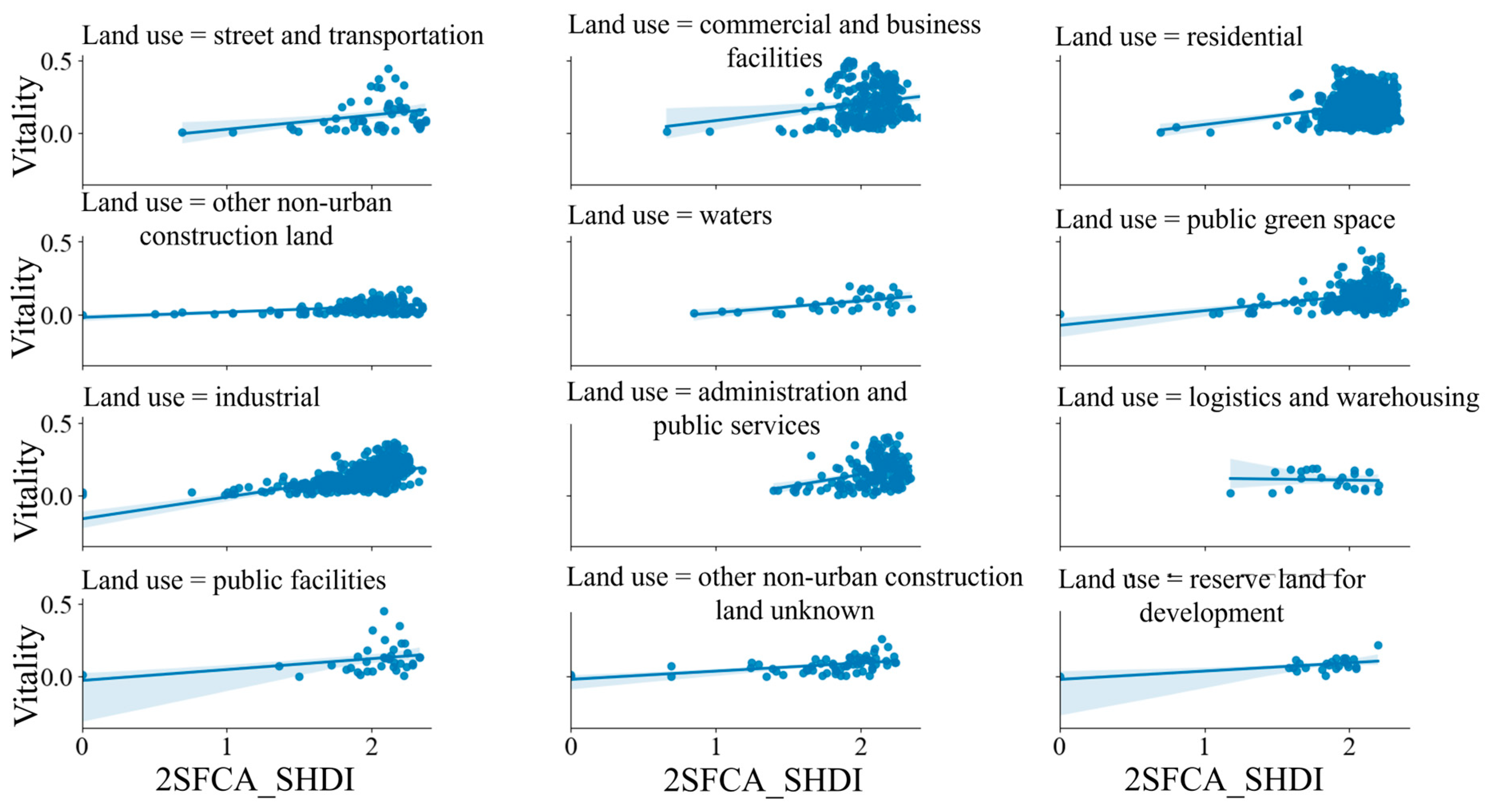

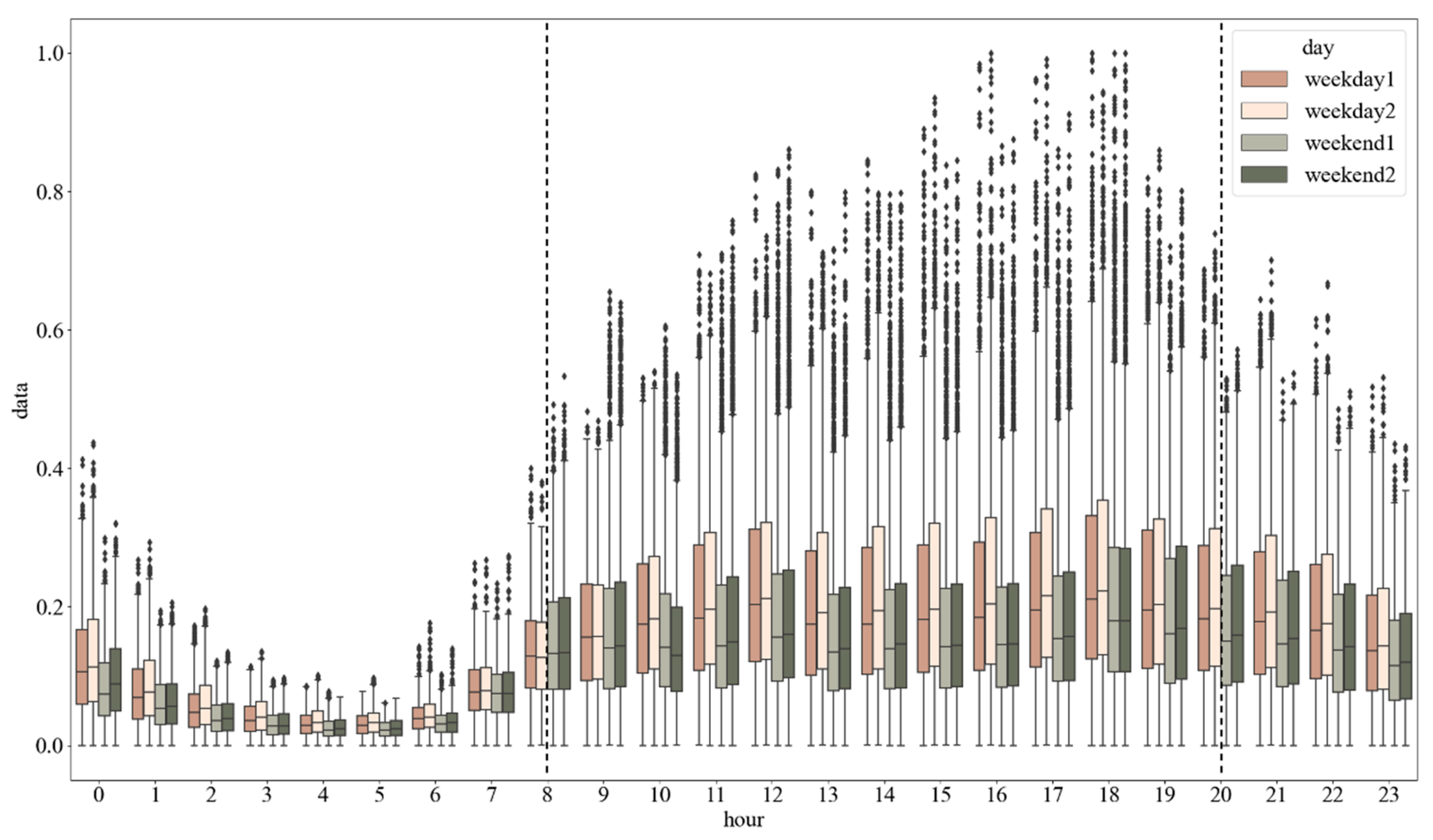
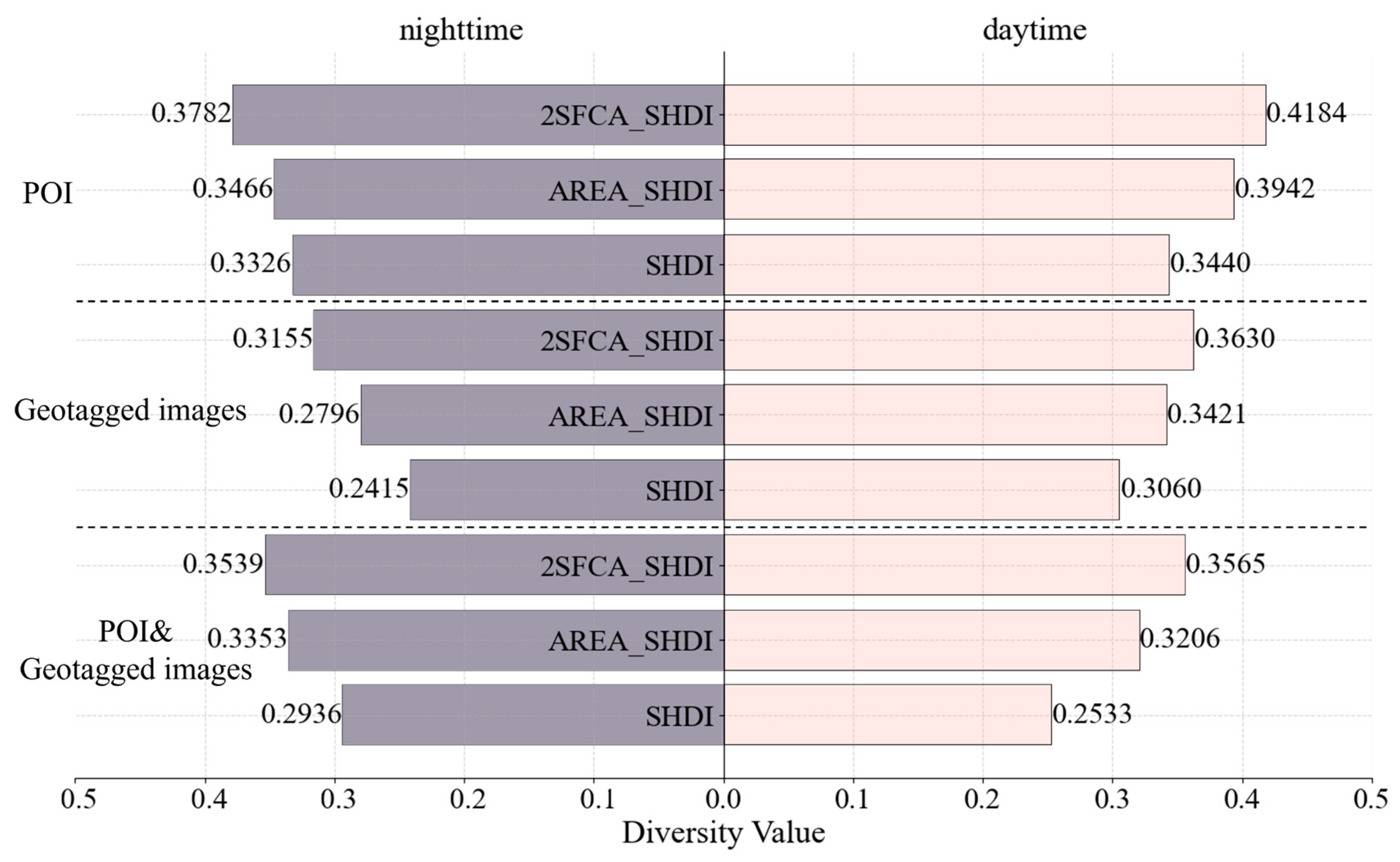
| Data Source | Data Volume | Date | URL | Purpose |
|---|---|---|---|---|
| Baidu heatmap | 10,000+ hourly recording points | 7–10 January 2023 | https://huiyan.baidu.com/products/popgeoapiservice (accessed on 1 February 2025) | proxy for vitality |
| Gaode POI | 685,390 pois | June 2023 | https://lbs.amap.com/api/webservice/guide/api/search (accessed on 1 February 2025) | proxy for urban functional semantics |
| Geo-tagged image (from weibo) | 75,663 images | 7 December 2022–23 March 2023 | https://weibo.com/ (accessed on 1 February 2025) | proxy for urban scene visual semantics |
| Shenzhen planning map | 60,259 land-use parcels (11 categories) | 2022 | https://pnr.sz.gov.cn/d-xgmap/ (accessed on 1 February 2025) | calculate accessibility and dominant land-use types |
| Diversity Indicator | Region H | Region M | Region N |
|---|---|---|---|
| SHDI | 119.25 | 249.70 | 58.40 |
| AREA_SHDI | 121.22 | 290.01 | 71.14 |
| 2SFCA_SHDI_Weekday1 | 129.64 | 295.95 | 71.56 |
| 2SFCA_SHDI_Weekday2 | 129.32 | 295.90 | 71.55 |
| 2SFCA_SHDI_Weekend1 | 127.87 | 295.99 | 71.47 |
| 2SFCA_SHDI_Weekend2 | 121.11 | 296.01 | 71.44 |
| Variable | Coefficient | Std. Error | Adjusted R2 |
|---|---|---|---|
| Model 1 (Other_factor + Richness) | |||
| Constant | 0.0759 | 0.0061 | 0.259 |
| Slope | 0.0010 | 0.0004 | |
| Accessibility to bus station | −0.0006 | 0.0001 | |
| Housing prices | 0.0000 | 0.0000 | |
| Building height | 0.0066 | 0.0003 | |
| Diversity: Richness | 0.0038 | 0.0004 | |
| Model 2 (Other_factor + Simpson) | |||
| Constant | 0.0750 | 0.0073 | 0.247 |
| Slope | 0.0011 | 0.0004 | |
| Accessibility to bus station | −0.0005 | 0.0001 | |
| Housing prices | 0.0000 | 0.0000 | |
| Building height | 0.0070 | 0.0003 | |
| Diversity: Simpson | 0.0450 | 0.0084 | |
| Model 3 (Other_factor + SHDI) | |||
| Constant | 0.0744 | 0.0069 | 0.250 |
| Slope | 0.0011 | 0.0004 | |
| Accessibility to bus station | −0.0006 | 0.0001 | |
| Housing prices | 0.0000 | 0.0000 | |
| Building height | 0.0068 | 0.0003 | |
| Diversity: SHDI | 0.0209 | 0.0033 | |
| Model 4 (Other_factor + AREA SHDI) | |||
| Constant | −0.0241 | 0.0136 | 0.265 |
| Slope | 0.0011 | 0.0004 | |
| Accessibility to bus station | −0.0004 | 0.0001 | |
| Housing prices | 0.0000 | 0.0000 | |
| Building height | 0.0066 | 0.0003 | |
| Diversity: AREA_SHDI | 0.0666 | 0.0066 | |
| Model 5 (Other_factor + 2SFCA SHDI) | |||
| Constant | −0.0466 | 0.0140 | 0.273 |
| Slope | 0.0011 | 0.0004 | |
| Accessibility to bus station | −0.0004 | 0.0001 | |
| Housing prices | 0.0000 | 0.0000 | |
| Building height | 0.0066 | 0.0003 | |
| Diversity: 2SFCA_SHDI | 0.0791 | 0.0069 | |
Disclaimer/Publisher’s Note: The statements, opinions and data contained in all publications are solely those of the individual author(s) and contributor(s) and not of MDPI and/or the editor(s). MDPI and/or the editor(s) disclaim responsibility for any injury to people or property resulting from any ideas, methods, instructions or products referred to in the content. |
© 2025 by the authors. Published by MDPI on behalf of the International Society for Photogrammetry and Remote Sensing. Licensee MDPI, Basel, Switzerland. This article is an open access article distributed under the terms and conditions of the Creative Commons Attribution (CC BY) license (https://creativecommons.org/licenses/by/4.0/).
Share and Cite
He, Z.; Zhang, X. Towards More Reliable Measures for “Perceived Urban Diversity” Using Point of Interest (POI) and Geo-Tagged Photos. ISPRS Int. J. Geo-Inf. 2025, 14, 91. https://doi.org/10.3390/ijgi14020091
He Z, Zhang X. Towards More Reliable Measures for “Perceived Urban Diversity” Using Point of Interest (POI) and Geo-Tagged Photos. ISPRS International Journal of Geo-Information. 2025; 14(2):91. https://doi.org/10.3390/ijgi14020091
Chicago/Turabian StyleHe, Zongze, and Xiang Zhang. 2025. "Towards More Reliable Measures for “Perceived Urban Diversity” Using Point of Interest (POI) and Geo-Tagged Photos" ISPRS International Journal of Geo-Information 14, no. 2: 91. https://doi.org/10.3390/ijgi14020091
APA StyleHe, Z., & Zhang, X. (2025). Towards More Reliable Measures for “Perceived Urban Diversity” Using Point of Interest (POI) and Geo-Tagged Photos. ISPRS International Journal of Geo-Information, 14(2), 91. https://doi.org/10.3390/ijgi14020091






